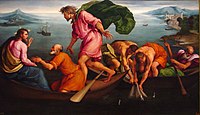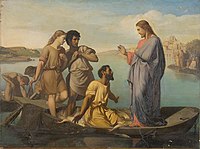
Miraculous catch of fish
The miraculous catch of fish, or more traditionally the miraculous draught of fish(es), is either of two events commonly (but not universally)[1] considered to be miracles in the canonical gospels. The miracles are reported as taking place years apart from each other, but in both miracles apostles are fishing unsuccessfully in the Sea of Galilee when Jesus tells them to try one more cast of the net, at which they are rewarded with a great catch (or "draught", as in "haul" or "weight"). Either is thus sometimes called a "miraculous draught of fish".
Overview[edit]
In the Gospel of Luke (Luke 5:1–11),[2] the first miraculous catch of fish takes place early in the ministry of Jesus and results in Peter as well as James and John, the sons of Zebedee, joining Jesus vocationally as disciples.[3][4][5]
The second miraculous catch of fish is also called the "miraculous catch of 153 fish", and seems to recall the first catch. It is reported in the last chapter of the Gospel of John (John 21:1–14)[6] and takes place after the Resurrection of Jesus.[7][8][9][10]
In Christian art, the two miracles are distinguished by the fact that in the first miracle Jesus is shown sitting in the boat with Peter, while in the second miracle he is standing on the shore.
Interpretations[edit]
Friedrich Justus Knecht: a parable of the Church[edit]
The Catholic German theologian Friedrich Justus Knecht (d. 1921) wrote that,







